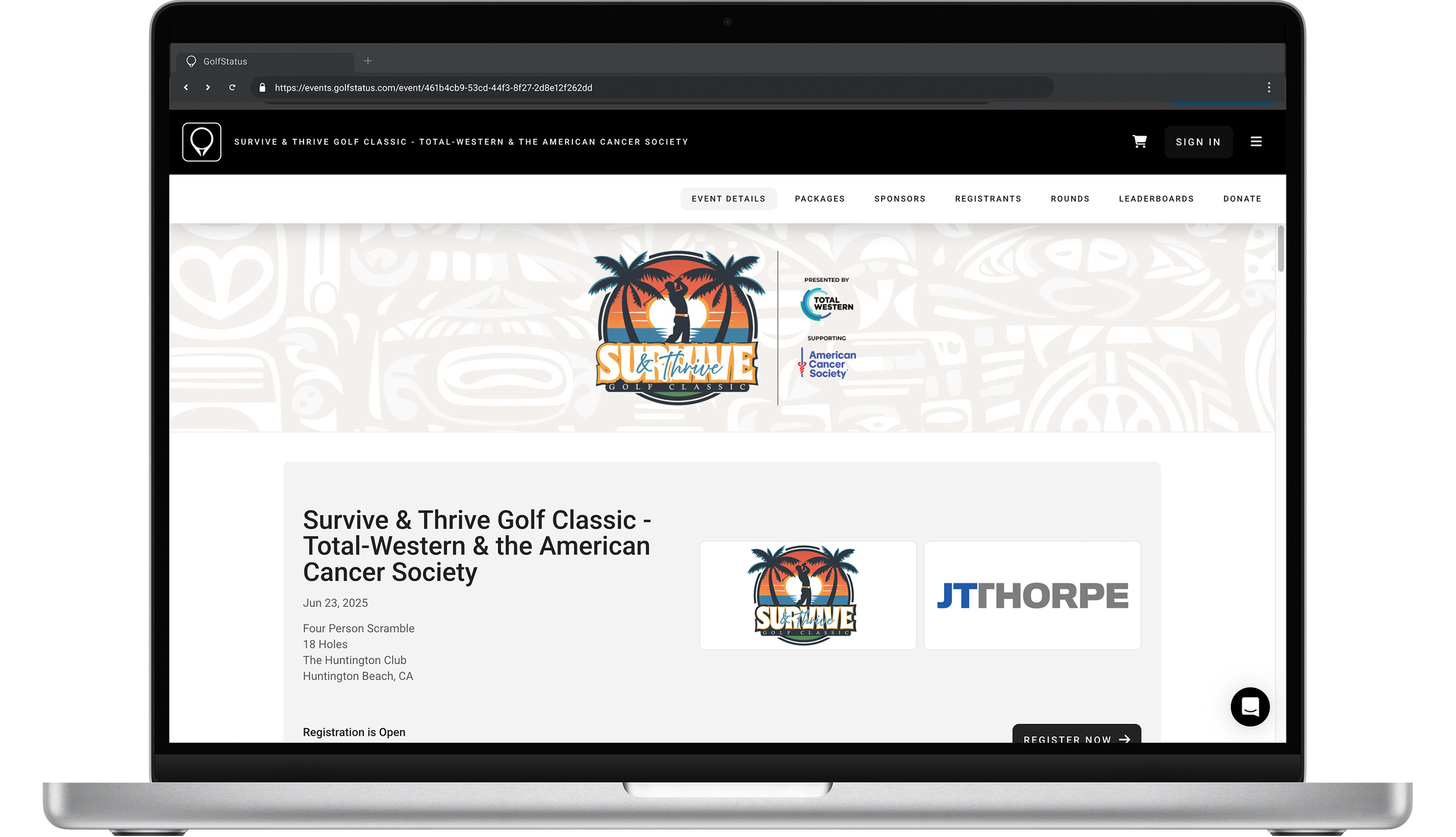There’s an important golf tournament to-do that often gets lost in the shuffle of securing a golf facility, promoting the event, recruiting sponsors, registering golfers, and finalizing details: branding. And while it might just seem like just one more task to cross off your list, branding plays a critical role in the success of your golf event.
Branding your tournament is a key factor in its success! Project Purple uses consistent brand colors and the organization’s logo in its golf tournament branding.
Branding your tournament is more than just slapping your logo on a flyer and calling it a day. Strong, consistent branding can elevate your tournament in big ways, building credibility, making your event more recognizable, helping attract sponsors and participants, and giving you a more professional, polished look.
Let’s break down why branding matters for your tournament and how to build a cohesive brand—no design degree required.
Why Branding Matters for Your Golf Event
1. It Builds Trust
A clean, consistent visual identity helps people take your tournament seriously. When your materials look polished, potential sponsors, golfers, and donors are more likely to want to be part of it. They see that you’ve put care and thought into your event, and they can assume the overall tournament experience will reflect that, too.
2. It Creates Recognition
If someone sees your tournament’s logo on a flyer, then again on a social media post or in an email, and again on a t-shirt—guess what? They’re more likely to remember it! Branding keeps your tournament top-of-mind, helping grow participation and support for your mission.
3. It Makes Your Event Stand Out
There are a lot of charity golf tournaments out there. And while that’s certainly not a bad thing, it does make it a bit harder to stand out. That’s where branding comes in. Good branding makes your tournament pop. Whether it’s a clever logo, a bright color scheme, or a unique event name, these elements help make your tournament memorable.
4. It Improves Your Marketing
Clear branding makes it easier for you and your team to create marketing materials that look good and work well. From social posts to printed flyers to digital ads, branding helps ensure your marketing efforts are cohesive and easily recognizable by potential golfers, sponsors, and supporters.
Your Tournament’s Brand: What It Should Include
There’s good news for tournament organizers who don’t have access to a designer or a creative team: you don’t need a huge style guide or agency-designed logo to build an effective brand for your charity golf tournament. Simply start with these key elements:
Event Name
Give your tournament a name that’s fun, catchy, and theme or mission-related to help the event stand out and be remembered. Some examples from tournaments powered by GolfStatus:
Fairway to Heaven Memorial Golf Scramble
Survive & Thrive Golf Classic
Drive Out Hunger Golf Classic
Tee Off for Hope
Habitat FORE! Humanity
Putt Putt Fore Puppies
Drive to Cure Cancer Golf Classic
Drive for Hope Golf Outing
Teeing Up Tomorrow
Chip In for Children’s Charity Golf Outing
Birdies for Bravery
If your cause doesn’t lend itself to a punny name, don’t sweat—simply including your organization’s name or mission in the name can be just as powerful for branding.
Your tournament’s name and logo should appear on all promotional materials, including your event website.
Logo
Use your nonprofit’s existing logo or create a unique one for your tournament. Keep it simple, scalable (so it looks good no matter where or what size it’s used), and legible. If you choose to create a separate logo specifically for the golf tournament, be sure that it complements your organization’s overall branding if and when they’re used together.
Color Palette
Choose two to three colors and use them consistently in all materials. Online tools like Coolors or Canva’s color palettes can help you narrow in on colors that look sharp and work well together. Again, it’s a good idea to choose a palette that’s in harmony with your organization’s logo so they don’t clash when used in tandem.
Typography
Stick with one or two fonts that are easy to read. You don’t need anything fancy, but it’s a good idea to avoid ornate script or overly decorative fonts. Consider using bold or all caps for headlines, and a clean sans-serif font for body text.
Imagery
Use consistent imagery, such as golf-themed icons or graphics, mission-related photos, or high-quality shots from previous golf tournaments. Bonus points if you can feature people having fun on the golf course!
Assemble imagery from past years’ golf tournaments that emphasize the event’s brand, like the above image from a glow-in-the-dark golf fundraiser.
Branding Tips for Non-Designers
You don’t need to be a design pro to create a great-looking brand for your charity golf tournaments. Try these tips:
Use Canva (Or a Similar Tool)
Canva is a non-designer’s best friend. It’s free (with an upgraded paid Pro version), easy to use, and packed with great-looking templates for flyers, social posts, email graphics, posters, and much more. You can upload your logo, save your colors and fonts, and keep everything consistent across your tournament’s promotional materials.
Create a “Mini” Brand Guidelines Document
Put all your tournament’s visual elements, including logos, colors, fonts, and a few sample images, in one simple document. This makes it easier to keep everything aligned and share with volunteers, board members, or sponsors helping with marketing. You might also consider creating a shareable Google Drive folder (or other file sharing platform like OneDrive or Dropbox) where the guidelines document and all the branding elements are stored for easy access.
Free Templates
GOLF TOURNAMENT PROMOTIONAL FLYER TEMPLATES
Save time and create polished, professional-looking flyers to market your golf tournament with these free templates. These editable Canva flyer templates are designed to help you drive participation, boost event visibility, and make your tournament look great—no design skills required.
Stick to Your Chosen Colors & Fonts
Resist the urge to go rogue with your design choices! Consistency is what creates a recognizable brand, so use the same colors, fonts, and design style everywhere, from your promotional emails to your event signage.
Make it Legible
Design rule number one: If people can’t read it, it doesn’t work. Use high contrast (think dark text on a light background), avoid crowded layouts and clutter (white space is your friend), and don’t overuse fancy fonts to make all your pieces as readable as possible.
Use Your Branding Everywhere
Include your tournament logo on player gifts like koozies to reinforce the brand and make your event more memorable.
You’ve gone to the effort of creating a brand for your event, so make sure you use it everywhere! It should be front and center on:
Your tournament website
Flyers and posters
Social media graphics
Sponsorship packets
Event signage and banners
Staff and volunteer shirts
Cart signs and scorecards
Branding & Sponsorship Go Hand-in-Hand
Your tournament’s branding doesn’t just help you look good—it can also help you raise more money. A strong, professional look makes your event more attractive to sponsors. It gives them confidence that your tournament will be well-run and their logo and brand will be presented in the best possible manner.
When pitching tournament sponsorships, consider using branded mockups when possible to show how their logo will appear on signage, cart signs, or social posts. The better your branding, the easier it is for sponsors to picture their brand alongside yours.
Final Thoughts
Branding your golf tournament doesn’t have to be complicated. With a few simple elements and a little bit of consistency, you can create a strong, professional visual identity that builds trust, attracts attention, and sets your event up for success.
Even if you’re not a graphic designer, tools like Canva and clear intention can go a long way. And remember: good branding isn’t about being flashy, it’s about being clear, consistent, and authentic to your mission.
Need help streamlining the rest of your tournament? GolfStatus makes it easy to build out a professional-looking event website (complete with your branding), manage registrations, and handle sponsor visibility all in one place.



















































